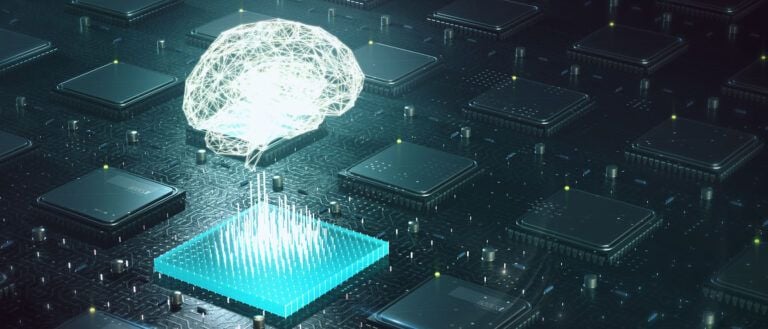Mastering the Basics: A Step-by-Step Guide to Understand Machine Learning

- How to Define a Model for Your Data and Make it Learn?
- What are Regression Models and How to Use Them?
- How to Classify Data Using Classification Models
- How to Develop Unsupervised Models and Why?
- How to Use Hidden Parameters to Improve the Accuracy of a Model’s Predictions
- Frequently Asked Questions
- Looking to Learn Machine Learning Online?
Machine learning is transforming industries and changing how we approach data analysis. According to a Contrive Datum Insights study, the global machine learning market is expected to reach $209.91 billion by 2030. This projection, therefore, shows why now is a good time to learn machine learning to stay ahead of the curve and improve your skills. In this guide, we go through the fundamentals of machine learning and learn how to apply them to real-world problems.
How to Define a Model for Your Data and Make it Learn?
Follow these steps to learn machine learning, define a machine learning model for your data, and train it:
- Choose the best algorithm for the problem, such as a decision tree or a neural network
- Clean the data, scale it, and divide it into training and testing sets before beginning
- Defining the model architecture includes specifying the number of layers, neurons, and activation functions used
- Compile the model by including a loss function and an optimizer
- Train the model by running it through the training data and adjust the weights based on the error
- Use metrics such as accuracy, precision, recall, or an F1 score to assess the model’s performance on the testing data
- To improve the model’s performance, fine-tune its hyperparameters, such as the learning rate or regularization parameters
- Deploy the model in a production environment to forecast new data
ALSO READ: Artificial Intelligence vs. Machine Learning: What are the Key Differences?
What are Regression Models and How to Use Them?
 Regression models are a type of statistical analysis. A dependent variable’s relationship with one or more independent variables is modeled using regression models. Overall, the main goal of regression analysis is to find a mathematical equation that can predict the value of the dependent variable based on the value(s) of the independent variable(s). Linear and logistic regression are the most commonly used regression models in machine learning. While linear regression is used for continuous dependent variables, logistic regression is used for binary or categorical dependent variables. To learn machine learning and use regression models, you must first complete the following steps:
Regression models are a type of statistical analysis. A dependent variable’s relationship with one or more independent variables is modeled using regression models. Overall, the main goal of regression analysis is to find a mathematical equation that can predict the value of the dependent variable based on the value(s) of the independent variable(s). Linear and logistic regression are the most commonly used regression models in machine learning. While linear regression is used for continuous dependent variables, logistic regression is used for binary or categorical dependent variables. To learn machine learning and use regression models, you must first complete the following steps:
- Predict future values: Regression models are used to predict the value of a dependent variable based on the values of one or more independent variables
- Identify relationships: These models are used to determine the strength of a relationship between two or more variables
- Make decisions: Use regression models to make decisions based on the model’s predictions or insights
- Optimize performance: The same can be used to optimize performance by identifying and adjusting the factors that contribute to a specific outcome
- Test hypotheses: Use regression models to confirm or refute hypotheses about the relationship between variables
Understanding regression models to learn machine learning can be a powerful tool for predicting or modeling the relationship between variables. However, accurate results will require careful consideration of the data and proper model selection.
ALSO READ: 4 Types of Machine Learning and How to Build a Great Career in Each
How to Classify Data Using Classification Models
Define the Issue
Define the problem to be solved and the classification model to employ. For instance, categorizing emails as spam or not spam.
Collect Data
Gather the information needed for the analysis. At the same time, check the data to ensure it is clean, accurate, and representative of the population.
Prepare the Data
Before running the classification analysis, cleaning and preparing the data is necessary. This includes removing missing values, outliers, email addresses, and personally identifiable information and if necessary, transforming that data.
Divide the Data
Divide the data into two sets—one for training the model and one for testing and evaluating its performance. In brief, a typical split for training and testing data should be 70/30 or 80/20.
Select the Classification Model
Select the classification model that best fits the data and problem. Commonly used classification models include decision trees, k-nearest neighbors (k-NN), logistic regression, and support vector machines.
Train the Model
This ensures that the model will learn from the data’s patterns and relationships and use them to make predictions. In the email example, for instance, train the model to recognize the characteristics of spam emails using the labeled data.
Evaluate the Model
Using the testing set, evaluate the model’s performance. Moreover, to determine how well the model is performing, look at metrics such as accuracy, precision, recall, and F1-score. Additionally, use the testing set to determine the model’s classification accuracy in recognizing new emails as spam or not spam.
Refine the Model
If necessary, refine the model by adjusting the parameters or using a different classification model. Also, you may need to repeat this step a few times to get the best model possible.
Use the Model
The application of the trained and evaluated model to new data can lead to making predictions. Here, in the email example, the model helps determine whether an incoming email is spam or not.
How to Develop Unsupervised Models and Why?
Unsupervised learning aims to discover hidden patterns and structures in data without using predefined outcomes or labels. Furthermore, developing unsupervised models involves taking a few steps. First, define the problem to be solved and select the type of unsupervised model to be used. Second, gather and prepare the data, cleaning and transforming it as needed. Next, train the model using an unsupervised learning algorithm such as clustering or dimensionality reduction. Finally, evaluate the model’s performance and use it to gain insights into the data. On the whole, creating unsupervised models can be useful for a variety of applications, including customer segmentation, anomaly detection, and image or text analysis.
How to Use Hidden Parameters to Improve the Accuracy of a Model’s Predictions
 Here are some examples of how to use hidden parameters to improve the accuracy of the model’s predictions:
Here are some examples of how to use hidden parameters to improve the accuracy of the model’s predictions:
- Find the hidden parameters: Look for variables that are not directly observable but may affect the model’s predictions
- Feature engineering: It is the process of extracting meaningful features from data that can capture the impact of hidden parameters
- Complex models: Using more complex models, such as neural networks, ascertains the relationships between the hidden parameters and the output
- Hyperparameter tuning: Modify the model’s hyperparameters to incorporate the hidden parameters better
Including hidden parameters in the model can improve its accuracy and make more accurate predictions. Again, this is handy for applications such as image recognition, natural language processing, and fraud detection.
Frequently Asked Questions
What is Machine Learning?
Machine Learning (ML) is a subfield of Artificial Intelligence (AI) that enables computers to learn and improve based on their experiences without being explicitly programmed.
How Can Professionals Learn Machine Learning?
Professionals can learn machine learning through a variety of online courses, books, tutorials, and hands-on experience.
What are the Different Types of Machine Learning?
We can classify machine learning into supervised learning, unsupervised learning, semi-supervised learning, reinforcement learning, and deep learning.
What are Some Popular Machine Learning Algorithms?
Linear regression, logistic regression, decision trees, random forests, k-nearest neighbors, and support vector machines are some popular machine learning algorithms.
How Can Machine Learning be Applied in Various Industries?
Various industries—healthcare, finance, e-commerce, manufacturing, and transportation—can benefit from optimizing processes, predictions, anomaly detection, and decision-making.
What are Some Best Practices for Machine Learning Implementation?
Defining clear goals, selecting appropriate algorithms, ensuring data quality and privacy, and regularly monitoring and updating the model are some best practices for machine learning implementation.
ALSO READ: How to Become a Machine Learning Engineer and Have a Lucrative Career
Looking to Learn Machine Learning Online?
In the final analysis, learning machine learning can be a valuable asset to improve data analysis skills and make better decisions. Moreover, machine learning techniques such as regression models can help achieve end goals, whether it is predicting future values, identifying relationships, making decisions, optimizing performance, or testing hypotheses. Develop and use regression models to gain insights into data, make accurate predictions, and drive better outcomes by following the steps outlined in this guide. So, why wait? Begin by opting for these exciting online machine learning courses and artificial intelligence courses from Emeritus, and advance your skills!
Write to us at content@emeritus.org





